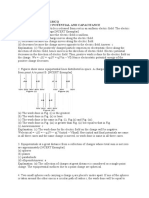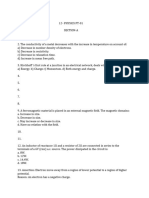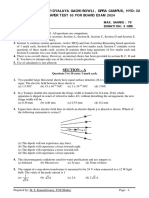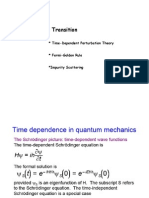Physics II Problems
Physics II Problems
Uploaded by
BOSS BOSSCopyright:
Available Formats
Physics II Problems
Physics II Problems
Uploaded by
BOSS BOSSOriginal Title
Copyright
Available Formats
Share this document
Did you find this document useful?
Is this content inappropriate?
Copyright:
Available Formats
Physics II Problems
Physics II Problems
Uploaded by
BOSS BOSSCopyright:
Available Formats
750
CHAPTER 22 Gausss Law
same as if all the charge were on the axis. Compare your result to the
result for a line of charge in Example 22.6 (Section 22.4).
22.32 . Two very large, nonconductFigure E22.32
ing plastic sheets, each 10.0 cm thick,
carry uniform charge densities s1 , s
s2 s3
s4
1
s2 , s3 , and s4 on their surfaces, as
shown in Fig. E22.32. These surface
charge densities have the values s1 =
A
B
C
- 6.00 mC>m2, s2 = + 5.00 mC>m2,
2
s3 = +2.00 mC>m , and s4 = +4.00
mC>m2. Use Gausss law to nd the
magnitude and direction of the electric
10 cm 12 cm 10 cm
eld at the following points, far from
the edges of these sheets: (a) point A, 5.00 cm from the left face of
the left-hand sheet; (b) point B, 1.25 cm from the inner surface of the
right-hand sheet; (c) point C, in the middle of the right-hand sheet.
22.33 . A negative charge -Q is placed inside the cavity of a
hollow metal solid. The outside of the solid is grounded by connecting a conducting wire between it and the earth. (a) Is there
any excess charge induced on the inner surface of the piece of
metal? If so, find its sign and magnitude. (b) Is there any excess
charge on the outside of the piece of metal? Why or why not?
(c) Is there an electric field in the cavity? Explain. (d) Is there an
electric field within the metal? Why or why not? Is there an electric field outside the piece of metal? Explain why or why not.
(e) Would someone outside the solid measure an electric field
due to the charge -Q? Is it reasonable to say that the grounded
conductor has shielded the region from the effects of the charge
- Q? In principle, could the same thing be done for gravity? Why
or why not?
PROBLEMS
22.34 .. A cube
has sides of length L = 0.300 m. It is placed
with one corner at the origin as shownSin Fig. E22.6. The electric
eld is not uniform but is given by E 1 -5.00 N>C # m2xn
13.00 N>C # m2zkN . (a) Find the electric ux through each of the six
cube faces S1 , S2 , S3 , S4 , S5 , and S6 . (b) Find the total electric
charge inside the cube.
S
22.35 . The electric eld E in Figure P22.35
Fig. P22.35 is everywhere parallel
z
to the x-axis, so the components E y
and E z are zero. The x-component
of the eld E x depends on x but not
3.0 m
on y and z. At points in the yz-plane
y
I
(where x = 0), E x = 125 N>C.
(a) What is the electric ux through
S
2.0 m II
E
surface I in Fig. P22.35? (b) What
is the electric flux through surface II? (c) The volume shown in
O
x
1.0 m
the gure is a small section of a
very large insulating slab 1.0 m thick. If there is a total charge of
the volume shown, what are the magnitude and
- 24.0 nC within
S
direction of E at the face opposite surface I? (d) Is the electric eld
produced only by charges within the slab, or is the eld also due to
charges outside the slab? How can you tell?
S
22.36 .. CALC In a region of space there is an electric eld E that
#
is in the z-direction and that has magnitude E = 1964 N>1C m22x.
Find the ux for this eld through a square in the xy-plane at z = 0
and with side length 0.350 m. One side of the square is along the
+ x-axis and another side is along the + y-axis.
22.37 .. The electric eld E 1 at Figure P22.37
one face of a parallelepiped is uniS
E2
form over the entire face and is
directed out of the face. At Sthe oppo6.00
site face, the electric eld E 2 is also
cm
uniform over the entire face and is
S
5.00
E1
30
directed into that face (Fig. P22.37).
cm
The two faces in question are
inclinedS at 30.0S from the horizontal,
while
E 1 and E 2 are both horizonS
S
tal; E 1 has a magnitude of 2.50 * 10 4 N>C, and E 2 has a magni4
tude of 7.00 * 10 N>C. (a) Assuming that no other electric eld
lines cross the surfaces of the parallelepiped, determine the net
charge contained within. (b) Is the electric eld produced only by
the charges within the parallelepiped, or is the eld also due to
charges outside the parallelepiped? How can you tell?
22.38 . A long line carrying a uniform linear charge density
+50.0 mC>m runs parallel to and 10.0 cm from the surface of a
large, at plastic sheet that has a uniform surface charge density of
- 100 mC>m2 on one side. Find the location of all points where an
a particle would feel no force due to this arrangement of charged
objects.
22.39 . The Coaxial Cable. A long coaxial cable consists of an
inner cylindrical conductor with radius a and an outer coaxial
cylinder with inner radius b and outer radius c. The outer cylinder
is mounted on insulating supports and has no net charge. The inner
cylinder has a uniform positive charge per unit length l. Calculate
the electric eld (a) at any point between the cylinders a distance r
from the axis and (b) at any point outside the outer cylinder.
(c) Graph the magnitude of the electric eld as a function of the
distance r from the axis of the cable, from r = 0 to r = 2c.
(d) Find the charge per unit length on the inner surface and on the
outer surface of the outer cylinder.
22.40 . A very long conducting tube (hollow cylinder) has inner
radius a and outer radius b. It carries charge per unit length +a,
where a is a positive constant with units of C>m. A line of charge
lies along the axis of the tube. The line of charge has charge per
unit length +a. (a) Calculate the electric eld in terms of a and
the distance r from the axis of the tube for (i) r 6 a; (ii)
a 6 r 6 b; (iii) r 7 b. Show your results in a graph of E as a
function of r. (b) What is the charge per unit length on (i) the inner
surface of the tube and (ii) the outer surface of the tube?
22.41 . Repeat Problem 22.40, but now let the conducting tube
have charge per unit length -a. As in Problem 22.40, the line of
charge has charge per unit length +a.
22.42 . A very long, solid cylinder with radius R has positive
charge uniformly distributed throughout it, with charge per unit
volume r. (a) Derive the expression for the electric eld inside the
volume at a distance r from the axis of the cylinder in terms of
the charge density r. (b) What is the electric eld at a point outside
the volume in terms of the charge
per unit length l in the cylinder? Figure P22.43
(c) Compare the answers to parts
(a) and (b) for r = R. (d) Graph
the electric-eld magnitude as a
function of r from r = 0 to
u
r = 3R.
22.43 .. CP A small sphere with
a mass of 4.00 * 10 -6 kg and
carrying a charge of 5.00 *
10 -8 C hangs from a thread near
a very large, charged insulating
You might also like
- Unit 14 (DESIGN OF SLENDER COLUMNS)Document33 pagesUnit 14 (DESIGN OF SLENDER COLUMNS)Zara Nabilah96% (25)
- Chapter 22 Gauss's Law: University Physics, 13e (Young/Freedman)Document17 pagesChapter 22 Gauss's Law: University Physics, 13e (Young/Freedman)Rachelle SaavedraNo ratings yet
- Balanis - Antenna Theory ReviewDocument17 pagesBalanis - Antenna Theory ReviewVulpe FlorianNo ratings yet
- Direct Versus Indirect Line of Sight (LOS) StabilizationDocument13 pagesDirect Versus Indirect Line of Sight (LOS) StabilizationMeluk 'Rhaina' de SilvaNo ratings yet
- Chapter 22 Suggested ProblemsDocument16 pagesChapter 22 Suggested ProblemsNatalie RussellNo ratings yet
- 1287Document3 pages1287Bee BeezzNo ratings yet
- Physics II ProblemsDocument1 pagePhysics II ProblemsBOSS BOSSNo ratings yet
- FIZ102E SuggestedProblemsDocument26 pagesFIZ102E SuggestedProblemsSelin PınarNo ratings yet
- Assignments of Physics II - PH1026 - Chapter 22-Week 2Document2 pagesAssignments of Physics II - PH1026 - Chapter 22-Week 2duongne2606No ratings yet
- DDP 4 Gauss's LawDocument2 pagesDDP 4 Gauss's LawAbhishek KushwahaNo ratings yet
- Electrostatics-Revision 1 22-23-1Document9 pagesElectrostatics-Revision 1 22-23-1President ObamaNo ratings yet
- Chapter 21: Electric Charge and Electric FieldDocument30 pagesChapter 21: Electric Charge and Electric FieldLam NguyenNo ratings yet
- Assignment PDFDocument30 pagesAssignment PDFHương Hà ĐàoNo ratings yet
- Xii Physics WDocument25 pagesXii Physics WFree Fire KingNo ratings yet
- Chapter 21: Electric Charge and Electric FieldDocument30 pagesChapter 21: Electric Charge and Electric FieldNguyễn Ngoc AnhNo ratings yet
- Ch22 SSM-1Document31 pagesCh22 SSM-1alyxs_1No ratings yet
- ElectrostaticsDocument28 pagesElectrostaticssonaliswain2345No ratings yet
- G12 Phy Pa2 Q.PDocument8 pagesG12 Phy Pa2 Q.PnjragavendaraNo ratings yet
- Electrostatics Revision 1 22 23Document7 pagesElectrostatics Revision 1 22 23President ObamaNo ratings yet
- Serway 6 e Problems 24Document13 pagesSerway 6 e Problems 24Iqra DadaNo ratings yet
- Physics II ProblemsDocument1 pagePhysics II ProblemsBOSS BOSSNo ratings yet
- Problem Set 2 - PhysicsDocument2 pagesProblem Set 2 - Physicskiana Jessica MonroeNo ratings yet
- Chapter 5 - Electric FieldDocument5 pagesChapter 5 - Electric FieldTHIÊN LÊ TRẦN THUẬNNo ratings yet
- Problems: Electric PotentialDocument5 pagesProblems: Electric PotentialFelipe López GarduzaNo ratings yet
- BIPLAB Assignment CLASS XIIDocument6 pagesBIPLAB Assignment CLASS XIImr.priyanshu2005No ratings yet
- S.N Questions 1.: BA CB CADocument8 pagesS.N Questions 1.: BA CB CAkush jindalNo ratings yet
- Chapter 1 Practice QuestionsDocument4 pagesChapter 1 Practice QuestionssanjaysajivkumarNo ratings yet
- p240w12 Mid1-2Document14 pagesp240w12 Mid1-2shlaeaNo ratings yet
- CH1 PYQ Physics and Chemistry .Document3 pagesCH1 PYQ Physics and Chemistry .sharmasunita.ss36No ratings yet
- Application of Physics II For: Midterm ExamDocument66 pagesApplication of Physics II For: Midterm ExamÖmer faruk SilNo ratings yet
- ELECTRIC CHARGES AND FIELDS (Pyq)Document5 pagesELECTRIC CHARGES AND FIELDS (Pyq)Abhishek Chaudhary100% (1)
- Auk Phys116 Alzu3bi CH22 by BaderDocument24 pagesAuk Phys116 Alzu3bi CH22 by Badersaiedali2005No ratings yet
- PHYF125 Tutorial Questions Tri 2 201617Document11 pagesPHYF125 Tutorial Questions Tri 2 201617Sufian PianNo ratings yet
- Physics Class 12 Chapter 1 Worksheet HHWDocument6 pagesPhysics Class 12 Chapter 1 Worksheet HHWSHAURYA NAGARNo ratings yet
- Physics Day 3Document4 pagesPhysics Day 3mehakNo ratings yet
- Physics 220 Homework: Spring 2008Document27 pagesPhysics 220 Homework: Spring 2008Jeff Pratt100% (1)
- Gauss'LawDocument7 pagesGauss'LawKavish CserNo ratings yet
- Classroom Assignment 3 With AnswersDocument3 pagesClassroom Assignment 3 With AnswersBishoy EmileNo ratings yet
- Aissce Asngmt CH - 01Document5 pagesAissce Asngmt CH - 016pqq745bq2No ratings yet
- HDHW Mcq-Ar Electrostatics Xii 2024Document14 pagesHDHW Mcq-Ar Electrostatics Xii 2024Shashwat SinghNo ratings yet
- XII-SCIENCE-24-25-SUMMER HOLIDAY ASSIGNMENT - RemovedDocument14 pagesXII-SCIENCE-24-25-SUMMER HOLIDAY ASSIGNMENT - RemovedSuvasish NathNo ratings yet
- XII PhysicsDocument4 pagesXII Physicsmadankshatriya800% (1)
- Xii Physics - Chapter 2term 1Document17 pagesXii Physics - Chapter 2term 1RahulNo ratings yet
- CH 2 PotentialDocument2 pagesCH 2 PotentialAnkit Kumar TripathyNo ratings yet
- CH 1 Electric Charges and FieldsDocument5 pagesCH 1 Electric Charges and Fieldskrekhanandu24No ratings yet
- Summer Holiday Homework Class Xii Subject: Physics: Chapter - 1: Electric Charges and FieldsDocument19 pagesSummer Holiday Homework Class Xii Subject: Physics: Chapter - 1: Electric Charges and FieldsRishiNo ratings yet
- 12TH PHYSICS FTDocument10 pages12TH PHYSICS FTABHISHEK PANDANo ratings yet
- Electric Charges and FieldDocument3 pagesElectric Charges and FieldgreenalcoveindiaNo ratings yet
- Physics Class Xii Sample Paper Test 03 For Board Exam 2024Document6 pagesPhysics Class Xii Sample Paper Test 03 For Board Exam 2024xkryxxzNo ratings yet
- Amol Potential Class 12Document9 pagesAmol Potential Class 12kaizenpro01No ratings yet
- 111年下A卷題庫Document10 pages111年下A卷題庫陳奕安No ratings yet
- Worksheet 1.2Document2 pagesWorksheet 1.2jasmeetsinghdute1No ratings yet
- Holiday Homework - Physics Grade XII 2024-2025Document9 pagesHoliday Homework - Physics Grade XII 2024-2025lakshanya8094No ratings yet
- PhysicsDocument17 pagesPhysicspaninikumar0000No ratings yet
- Important Questions For CBSE Class 12 Physics Gauss's Law PDFDocument52 pagesImportant Questions For CBSE Class 12 Physics Gauss's Law PDFkumarnpccNo ratings yet
- Sci 404 - Physics 2 - Midterm - Part IiDocument2 pagesSci 404 - Physics 2 - Midterm - Part IiJezreel GamboaNo ratings yet
- ELECTROSTATICS AssignmentsDocument5 pagesELECTROSTATICS AssignmentsGlendNo ratings yet
- Electrostatics 3Document2 pagesElectrostatics 3bys628h8skNo ratings yet
- Physics Assignement Summer Vacations Class XiiDocument23 pagesPhysics Assignement Summer Vacations Class Xiiarycool.vermaNo ratings yet
- Electric FieldDocument2 pagesElectric FieldAndres ZerrathoNo ratings yet
- Electron Beam-Specimen Interactions and Simulation Methods in MicroscopyFrom EverandElectron Beam-Specimen Interactions and Simulation Methods in MicroscopyNo ratings yet
- CBSE Class 1 English WorksheetDocument2 pagesCBSE Class 1 English WorksheetBOSS BOSS100% (1)
- CBSE Class 1 English WorksheetsDocument1 pageCBSE Class 1 English WorksheetsBOSS BOSSNo ratings yet
- CBSE Class 1 English WorksheetDocument1 pageCBSE Class 1 English WorksheetBOSS BOSSNo ratings yet
- CBSE Class 1 English WorksheetDocument1 pageCBSE Class 1 English WorksheetBOSS BOSSNo ratings yet
- CBSE Class 1 English WorksheetDocument1 pageCBSE Class 1 English WorksheetBOSS BOSSNo ratings yet
- CBSE Class 1 English WorksheetDocument1 pageCBSE Class 1 English WorksheetBOSS BOSSNo ratings yet
- CBSE Class 1 English WorksheetsDocument1 pageCBSE Class 1 English WorksheetsBOSS BOSSNo ratings yet
- CBSE Class 1 English WorksheetDocument1 pageCBSE Class 1 English WorksheetBOSS BOSSNo ratings yet
- CBSE Class 1 English WorksheetsDocument1 pageCBSE Class 1 English WorksheetsBOSS BOSSNo ratings yet
- CBSE Class 1 English Worksheets (16) - A Happy ChildDocument1 pageCBSE Class 1 English Worksheets (16) - A Happy ChildBOSS BOSSNo ratings yet
- CBSE Class 1 English Worksheets (19) - Bubble, Straw and ShoeDocument2 pagesCBSE Class 1 English Worksheets (19) - Bubble, Straw and ShoeBOSS BOSSNo ratings yet
- CBSE Class 1 English Worksheets (17) - After A BathDocument1 pageCBSE Class 1 English Worksheets (17) - After A BathBOSS BOSSNo ratings yet
- TN HSC Physics Bookback One MarksDocument1 pageTN HSC Physics Bookback One MarksBOSS BOSSNo ratings yet
- Additional One Marks Question Paper 1Document1 pageAdditional One Marks Question Paper 1BOSS BOSSNo ratings yet
- Gen Chem 1finalsDocument6 pagesGen Chem 1finalsMaricarDimasNo ratings yet
- Lande's G Factor and It's Expression, Expression For The Splitting of Atomic Energy Levels in Presence of Magnetic Field.Document3 pagesLande's G Factor and It's Expression, Expression For The Splitting of Atomic Energy Levels in Presence of Magnetic Field.arkit challam100% (1)
- Dak TailDocument6 pagesDak TailHendri HermawanNo ratings yet
- Aersp 312 Project 2 Final ReportDocument77 pagesAersp 312 Project 2 Final Reportapi-512393144No ratings yet
- Manual QuickFieldDocument256 pagesManual QuickFieldAnonymous 4kYNmixNo ratings yet
- Strength of Sandwich StructuresDocument6 pagesStrength of Sandwich StructuresPrudvi Krishna MaladiNo ratings yet
- Diagramme LogP-H - T-S À ImprimerDocument2 pagesDiagramme LogP-H - T-S À ImprimerRiad OualiNo ratings yet
- MKL 3 ReportDocument9 pagesMKL 3 ReportMatthew NelsonNo ratings yet
- Module 11 ElasticityDocument101 pagesModule 11 ElasticityAngel OñaNo ratings yet
- Physics Ss2 2nd Term e NotesDocument73 pagesPhysics Ss2 2nd Term e NotesAdio Babatunde Abiodun CabaxNo ratings yet
- Gen. Physics 1 Module 1Document5 pagesGen. Physics 1 Module 1wencylle casilNo ratings yet
- Pre-AP Chemistry Basic Thermochemistry Equilibrium and Organic Chemistry Notes Unit 112Document29 pagesPre-AP Chemistry Basic Thermochemistry Equilibrium and Organic Chemistry Notes Unit 112ChessmanRobbinsNo ratings yet
- Hvac Engineer - Equipment Heat GainDocument3 pagesHvac Engineer - Equipment Heat GainGeélisson Morello Cazotti0% (1)
- 268R Section 2 Notes: Haoyu GuoDocument11 pages268R Section 2 Notes: Haoyu GuoAndreas NeoNo ratings yet
- Quantum Mechanics Course Microsoft Power Point Time Dependent Perturbation TheoryDocument27 pagesQuantum Mechanics Course Microsoft Power Point Time Dependent Perturbation TheoryjlbalbNo ratings yet
- Perkuliahan Ke-4. Brittle and Ductile FractureDocument66 pagesPerkuliahan Ke-4. Brittle and Ductile Fracturekevin sembarangNo ratings yet
- Relafy 30 Amps T Typfe RelfayDocument2 pagesRelafy 30 Amps T Typfe RelfayMarudhasalamMarudhaNo ratings yet
- Effect of Skew Pole Count and Slot Count On Brushless PDFDocument6 pagesEffect of Skew Pole Count and Slot Count On Brushless PDFrakeshee2007No ratings yet
- Duncan-Chang - Parameters For Hyperbolic StressDocument5 pagesDuncan-Chang - Parameters For Hyperbolic StressOscar EduardoNo ratings yet
- Special Electrical Machines SyllabusDocument2 pagesSpecial Electrical Machines SyllabusSubhadra Devi. PNo ratings yet
- Purlin DesignDocument10 pagesPurlin Designitissa INGENIERIANo ratings yet
- 1.a Big Bang Theory Vs Steady State TheoryDocument20 pages1.a Big Bang Theory Vs Steady State TheoryRicardo R. Antonio Jr.No ratings yet
- Modeling of Internal Pressure and Thrust Load On Nozzles Using WRC 368Document5 pagesModeling of Internal Pressure and Thrust Load On Nozzles Using WRC 368m5416No ratings yet
- Boundary Vlaue Problem Module 4 With Solutions Page 1-20Document20 pagesBoundary Vlaue Problem Module 4 With Solutions Page 1-20maran.suguNo ratings yet
- Fenn 1998 (Science) ElectropsprayDocument8 pagesFenn 1998 (Science) Electropspraywoz300No ratings yet
- Physical Sciences P1 2019Document16 pagesPhysical Sciences P1 2019MfanafuthiNo ratings yet
- Rot. KinematicsDocument4 pagesRot. KinematicsNicolas Patrick OntiverosNo ratings yet







































































































